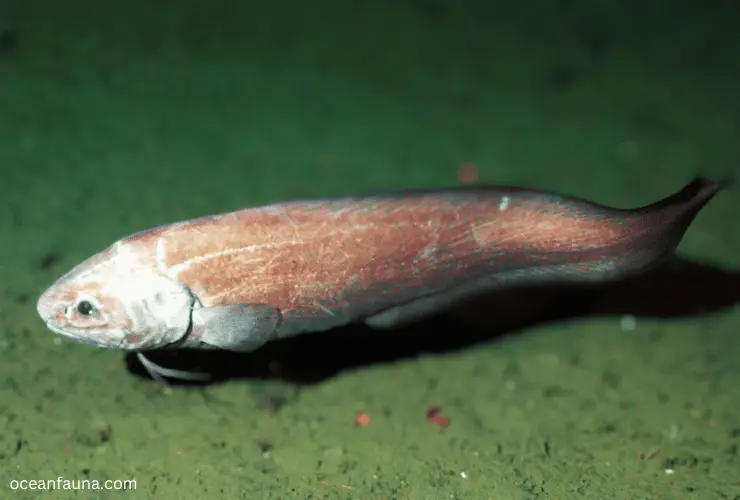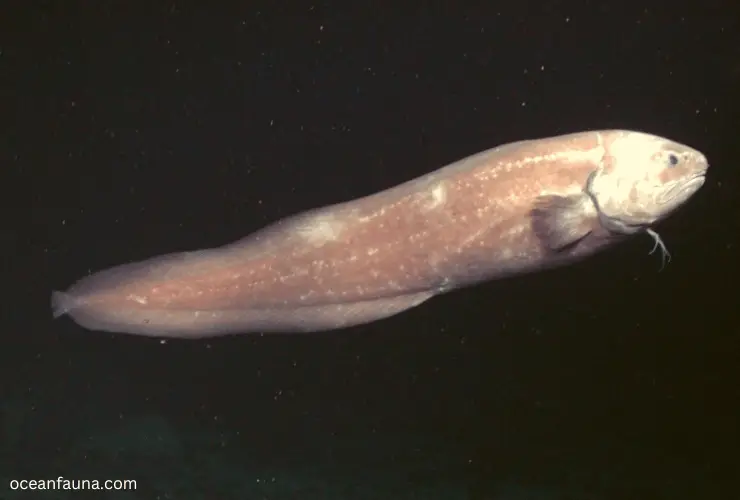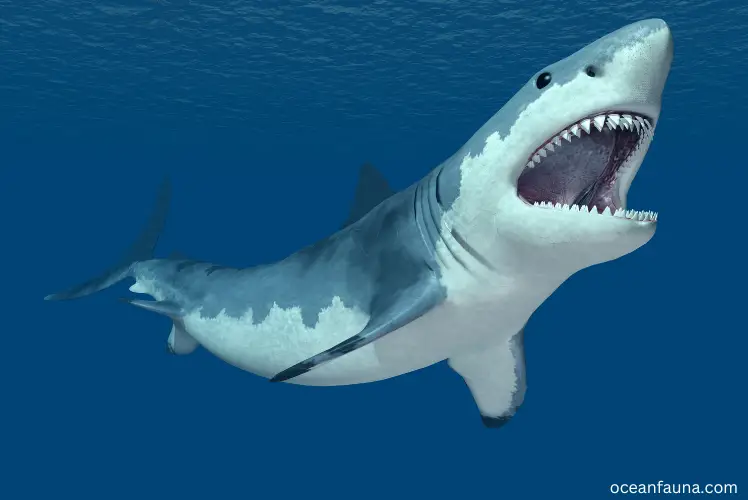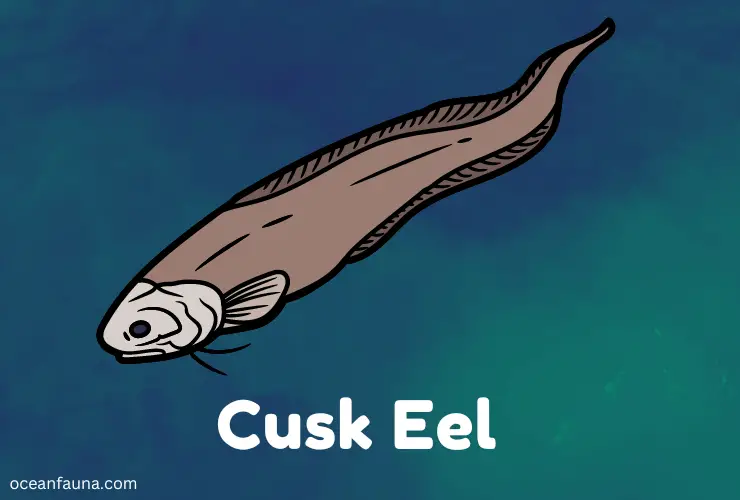Cusk eels are a type of deep-sea fish that has long caught the attention of both marine researchers and fish lovers. These fish have adapted to life in some of the most extreme environments on earth.
Contrary to popular belief, however, cusk eels are crucial to preserving the equilibrium of the oceans. They are predators and prey, giving many species food and a special niche.
Moreover, cusk eels have evolved to endure inhospitable environments like pressure and darkness, providing scientists with priceless knowledge and motivating conservation efforts.
In this article, I will help you better grasp cusk eels. Let’s examine their biology, ecology, and the crucial role they play in comprehending the fascinating world of the seas.
Let’s continue to discover the many wonders that these enigmatic fish possess, from their hunting techniques to their intriguing reproductive systems.
About Cusk Eel – A Quick Biology
| Parameters | Details |
| Scientific name | Ophidiiformes |
| Kingdom | Animalia |
| Families/family | Ophidiidae |
| Genus | Various, including Genypterus, Bassozetus, and Lepophidium |
| Class | Actinopterygii |
| Phylum | Chordata |
| Order | Ophidiiformes |
| Species | 240 species (grouped into 50 genera) |
| Habitat | Ranging from 200 to 2,500 meters. |
| Diet | Variety of small fish, crustaceans, and cephalopods. |
| Life Span | Up to more than 14 years. |
| Geographical range | found in oceans worldwide, including the Atlantic, Pacific, and Indian Oceans. |
| Size | growing up to 1 meter in length. |
| Weight | Few grams to several pounds but at most 20 lbs. |
Top 4 Mystery to Unleash: Cusk Eel
The following are the top 4 most frequent cusk eel mysteries.
Continental Slope: The continental slope is where the ocean floor drops steeply from the continental shelf to the ocean basin.
Cusk eels are commonly found in this area, where the water depth ranges from 200 to 2,000 meters.
Seamounts: Seamounts are underwater mountains rising from the ocean floor. They are known to attract various marine life, including cusk eels.
Ocean Trenches: Ocean trenches are the deepest parts of the ocean, often exceeding 6,000 meters. Cusk eels inhabit these trenches, including the Mariana Trench, the deepest part of the ocean.
Mid-Ocean Ridges: Mid- Ocean ridges are underwater mountain ranges that run through the middle of the ocean basins. Cusk eels are known to inhabit these ridges, particularly in areas where hydrothermal vents are present.
Description and Anatomy of Cusk Eel
Cusk eels range in size from 0.5 meters to an astounding 1 meter and are well-adapted to living in the ocean’s murky depths.
While some species have a pattern of dark dots or bands on their bodies, they are smooth and primarily black or brown.
This long, cylindrical animal also contains pectoral fins, an anal fin, and two dorsal fins, one on the head and the other towards the tail.
When it comes to navigating its habitat, this species is highly gifted. Dark, choppy seas require unique fins that make navigating the depths a little bit simpler.
Cusk eels are exceptional predators in deep water thanks to their unique characteristics.
Their tiny eyes, which are on their heads and allow them to scan their surroundings from above, add to their fearsome hunting skills.
Cusk eels have a sensitive lateral line that aids them in detecting motion and vibrations in the water, which helps them continue their stealthy approach.
The cusk eel’s swim bladder, which is oil-filled, gives them exceptional agility and allows them to travel up and down the water column with little effort. This is, however, a more spectacular adaptation.
Their skeletal structure is also quite simple, granting them distinct flexibility and allowing them to traverse through the deep’s tight crevices.
Overall, cusk eels are well-adapted for life in the deep sea. Their anatomy allows them to efficiently navigate and survive in their dark and sometimes extreme environment.
Behavior of Cusk Eel

Cusk eels are solitary creatures that are most active around dusk. During the day, they hide and take cover in the cracks and shadows of the seafloor.
Due to their opportunistic nature, these eels will eat any tiny fish, crabs, or invertebrates that wander into their territory.
They rely on their ability to blend in with their surroundings if a predator approaches too closely.
As a last option, they may also generate a bioluminescent liquid from their eyes to mislead the threat.
Cusk eels stand out for their adaptability and desire to survive in the ocean’s depths, even though they are not known for having evolved or complex behaviors.
Habitat, Range, and Distribution of Cusk Eel
Certain cusk eels may be found everywhere, from the Arctic to the Antarctic, lurking in the gloomy depths of the oceans.
Depending on the species, they may be found in various habitats; some favor the shallows and beaches, while others travel deep into deep-sea trenches.
Depending on the species, cusk eels may settle in rocky or firm-bottom areas to obtain protection and food, and some can inhabit midwater conditions.
Cusk eels have a population that covers the Mediterranean Sea, the Caribbean Sea, the Indian Ocean, the Pacific Ocean, and the Southern Ocean. They also occur in the North and South Atlantic Oceans.
The Range of Depth a Cusk Eel Can Go
So how deep can the cusk eel go? The depth to which a cusk eel can go may depend on several factors, including species, age, size, and environmental conditions.
Some species of cusk eels, such as the Abyssocottidae, are known to live exclusively in the deep sea and can withstand extreme pressure and cold temperatures. The highest recorded depth is 8370m at the Puerto Rico Trench.
Funny Things to Uncover – Cusk Eel The World’s Deepest Fish (Yeah Or Neah)
Is the cusk eel the world’s deepest fish? The cusk eel is not the world’s deepest fish. They are normally found at a depth of 1500 to 4300 meters. Other fish species can be found at even greater depths.
The world’s deepest fish known to date is the Mariana snailfish, normally found at depths of up to 8000 meters in the Mariana Trench in the western Pacific Ocean.
Other deep-sea fish species that inhabit extreme depths include the ghostfish, the deepwater scorpionfish (Congiopodidae), and the fangtooth.
Feeding Habits / Diet of Cusk Eel
Cusk eels have a variety of adaptations and diets.
They can swallow their food whole, have long bodies and sharp teeth, and eat prey larger than their body size thanks to their massively expanded stomachs.
Depending on their environment, they mostly consume tiny fish, crustaceans, and other invertebrates like crabs and shrimp.
Yet, certain cusk eels are known to eat bottom creatures, while others hunt for midwater food like tiny fish and squid.
They may go for extended periods without eating because they are nocturnal opportunistic hunters, a trait of their deep-sea habitat when food supplies are scarce.
Their ability to consume a wide range of prey allows them to survive in a habitat that can be challenging for other fish species.
Reproduction System of Cusk Eel
Cusk eels are oviparous, meaning they give birth by depositing eggs, which the male fertilizes externally. Many species and their environments have different rates of egg release and reproductive schedules.
The ocean currents carry these buoyant eggs, which eventually hatch at a time that depends on the species and water temperature.
These cusk eel larvae usually behave like plankton after hatching, wandering in the water until they mature into juvenile fish.
The rate of development varies depending on the species and the surrounding circumstances.
Taking this a step further, certain species of cusk eels, such as Antarctic cusk eels, are unique because their females possess a specialized reproductive organ. This organ is called a “spermatheca” that stores sperm from multiple males.
This contributes to the genetic variation of their offspring.
Life Cycle and Development of Cusk Eel
The young cusk eels change to a more ecological lifestyle as they age and descend to the ocean floor.
On average, the lifespan of a cusk eel is around 14 years, but the lifetime of the Antarctic cusk eel species might reach over 20 years due to its slow development rate.
Cusk eels exhibit a life cycle and growth process adapted to their deep-sea habitat. Their planktonic larvae disperse over a large ocean area.
They are flexible enough to survive the colder temperatures, scarce food sources, and challenging conditions of their marine realm by clinging to the ocean bed and gradually growing over time.
Importance of Cusk Eel in Ecosystem

Cusk eels play an important role as predators and prey in deep-sea ecosystems. In addition to influencing the aquatic ecosystems’ structure and composition.
These organisms support populations of smaller fish and invertebrates. Cusk eels are a major food source for several bigger predators.
Hence, their numbers and distribution have a significant impact on deep-sea ecosystems.
Moreover, some species of cusk eels contain symbiotic organisms, such as bacteria and parasites, which are crucial to the dynamics of the community and the cycling of nutrients.
Cusk eels are also economically significant, serving as commercial fisheries in some areas. They are often taken using bottom trawling and longlining techniques, then used to process fish oil and fishmeal or human food.
Predators of Cusk Eel
Cusk eels are an important prey species for a variety of marine predators, including:
Sharks

Some shark species, like the spiny dogfish and the Greenland shark, have strong enough oceanic dominance to even catch cusk eels. The shark’s strong teeth immediately destroy cusk eels since they cannot escape.
Dolphins

Some species of dolphins, such as the pilot whale, are known to feed on cusk eels. Dolphins are highly intelligent predators and use echolocation to locate and catch their prey.
Seabirds
Some species of seabirds, such as albatrosses, are known to feed on cusk eels. Seabirds use their sharp beaks and keen eyesight to catch and consume small fish and other marine organisms.
Other Fish
Cusk eels may also be preyed upon by other fish species, such as deep-sea anglerfish and cod.
These predators use a variety of strategies to catch their prey, such as luring them in with bioluminescent lures or ambushing them in the dark waters of the deep sea.
Relationship Between Cusk Eel and Humans
While cusk eels might not be significant to humans economically or culturally, they are an essential component of the complex deep-sea ecosystem.
They are not frequently actively targeted by fishermen, but bottom-trawl fisheries’ inevitable bycatch may reduce their populations in deep-sea fishing operations.
As a result, this can impair the population growth of such species.
Scientists and academics are interested in these creatures because they want to understand their ecology and keep track of the health of deep-sea habitats.
In order to keep their deep-sea habitat stable and live a healthy and balanced life, cusk eels play a crucial role.
High-Temperature Stress Effect on the Red Cusk-Eel
According to research, high temperatures can significantly impact cusk eels.
The study examined the physiological and behavioral responses of cusk eels to warming temperatures and found the following:
Metabolic rate: As temperatures increased, the metabolic rate of the cusk eels increased, indicating that they were using more energy to maintain their bodily functions.
Oxygen consumption: As the metabolic rate increased, the oxygen consumption of the cusk eels also increased, which could lead to oxygen depletion in the surrounding water.
Swimming behavior: The study found that as temperatures increased, the swimming behavior of the cusk eels changed.
They exhibited more erratic movements and spent less time swimming in a straight line, which could indicate that their cognitive or sensory abilities were impaired.
Survival: The study also found that cusk eels exposed to high temperatures for extended periods showed signs of stress. They had higher mortality rates than those kept in cooler water.
Overall, the study suggests that high temperatures can have a significant impact on the physiology and behavior of cusk eels, potentially affecting their survival and reproductive success in the long term.
First Record of Rare Cusk-Eel (Lamprogrammus niger)
A Rare Cusk Eel Sighted!~ Central Part of the Mid-Atlantic Ridge
According to research, the first documented sighting of the rare cusk-eel species, Lamprogrammus niger, is in the Mid-Atlantic Ridge’s central part.
The authors describe the characteristics and distribution of Lamprogrammus niger and the conditions under which it was observed in the Mid-Atlantic Ridge.
The distribution of this eel was from the Bay of Bengal to the Andaman Islands.
The research also gives details about the description of the eel discovered.
For example, the head is relatively large. The dorsal profile is slightly convex, and the eyes are small that are poorly developed with round pupils.
Researchers Name New Cusk-Eels Useful for Understanding Environment
A recent discovery of a new species of cusk eel found in the Gulf of Mexico.
The researchers from the University of Florida and the University of Kansas who discovered this new species believe it is a valuable addition to our understanding of the deep-sea environment and how the biodiversity of the Gulf of Mexico can affect marine life.
The newly described cusk eel species was discovered and has been named Lepophidium.
The researchers who discovered this species are morphologically distinct from other known cusk eels, with a unique combination of physical features and genetic markers.
For example, cusk eels in South Carolina can reach up to 6.5 feet, but Lepophidium barely reaches up to 1 foot.
Furthermore, naming and describing these new cusk eel species are important for conservation efforts.
FAQs
Are Cusk Eels Rare?
Cusk eels are typically not considered rare, but certain species are far less common than others.
Some cusk eel species are more prevalent than others. Their geographic range and type distribution are very diversified.
An excellent example of a species with a sizable population spread over the Atlantic and Pacific seas is the blackfin cusk eel (Bassozetus zenkevitchi).
However, the attention paid to some cusk eel species needs to be more noticeable. Certain species may be regarded as uncommon and understudied due to traits like a narrow geographic range or a deep-sea habitat.
For example, the abyssal cusk eel (Chilara taylori) is particularly challenging to locate, making it especially difficult to find and study.
Can You Touch a Cusk Eel?
Generally, humans should only touch cusk eels or other aquatic creatures if they are trained professionals.
Cusk eels have evolved to live in harsh circumstances deeper in the ocean’s depths. Their skin and bodily fluids can contain toxic components that can harm human health, such as skin irritation.
This is why it’s best to observe the exquisite creatures from a distance, keeping the animals safe from possibly dangerous contact.
For example, they may be hurt if touched, become helpless, or suffer from excessive tension. Observing marine life should be done with consideration for the animal’s native environment.
Do Cusk Eels Bite?
While cusk eels have huge jaws and pointed teeth, most people do not consider them dangerous.
These eels are often found in great depth, which means that people only occasionally come into contact with them.
Despite their distance, every animal with teeth can respond when it detects a threat or danger. There is a risk that a cusk eel may bite in self-defense if a person approaches it when it is nearby and tries to handle it.
The likelihood of a human being damaged or injured by a cusk eel’s bite is low, despite the species’ tiny size.
Nonetheless, this does not imply that a bite should be ignored because every wound is susceptible to infection.
Cleaning the bitten area is important; medical assistance may be needed in some situations.
Conclusion
Dr. Tracey Sutton, professor at the Department of Marine and Environmental Sciences, claims that “cusk eels are significant members of deep-sea ecosystems. They serve as both predators and prey” (Sutton, 2017). Researchers are also interested in cusk eels because they have the potential to provide humans with a sustainable source of protein. To better comprehend their biology, ecology, and potential effects of commercial exploitation, more research is necessary. But in the Solomon Sea, West Pacific, marine biologists found a brand-new cusk-eel species of Luciobrotula (Teleostei, Ophidiidae). If you want to dive into the mystery, read this research report.


2 thoughts on “Cusk Eel: The Most Diverse Groups of Deep Ocean Creatures”